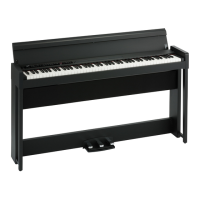9
The metronome
TheC1/C1Airisequippedwithametronome,whichcanbe
changedtoabellsound,whichisconvenientforpracticing.
Turning on/o the metronome
1. Press the METRONOME buon.
The buon lights up, and the
metronome starts.
2. To stop the metronome, press the METRONOME buon
again.
Thebuonturnso.
Specifying the tempo
Regardless of whether the
metronome is turned on or
o, press the DISPLAY but-
ton,andthen,aftertheTEMPOLEDislit,pressthe+or
–buontochangethetempo.
Theseingrangeis𝅘𝅥=40–240.
Toreturntothedefaultseing(120),simultaneouslypress
the+and–buons.
ThetempocanalsobespeciedintheMetronomeSet-
tingsMode.
Specifying the Time Signature, Volume, Accent
Sound, Tempo and Sound
1. Hold down the METRONOME buon until the Met-
ronome Seings Mode is entered.
TheMETRONOMEbuonblinks.
2. Press the appropriate buon shown below to select a
parameter and display its seing in the display, and
then press the + or – buon to change the seing.
Torestorethedefaultseing,simultaneouslypressthe
+and–buons.
Hold down
the Metronome Settings Mode
Time Signature
Volume
Sound
Setting
(Button)
Setting Range
Default
setting
AccentSound
( )
oFF(
noaccentsound
),
on1(emphasizedsoundfortheaccentbeat),
on2(
bellsoundfortheaccentbeat
)
o
Tempo( )
40–240(sameastemposeing) 120
Sound( )
1(acoustic),2(electronic) 1
TimeSignature
(PART1)
02(2/4),03(3/4),04(4/4),06(6/4) 04
Volume
(PART2)
01–13 10
3. After changing the seing, press the METRONOME
buon to exit the Metronome Seings Mode.
WhentheMetronomeSeingsModeisexited,theMET-
RONOMEbuonreturnstoitslightingstatus(litornot
lit)beforetheMetronomeSeingsModewasentered.
Byperformingthe“Saveparameterseings”(seepage
13) operation before the C1/C1 Air is turned o, the
seingsspeciedforthesound,accentsoundandvol-
umebeforetheC1/C1Airwasturnedocanbesaved
asthedefaultseings.
Touch settings
Thekeyboardsensitivity,ortouch,canbeprogrammed.
To change the seing, hold down the TOUCH buon and
press the + or – buon beside the display.
02
01
03
05
Loudness
Quiet
Quiet
Loud
Playing strength
04
Display Touch sensitivity
001 Light.Loudnotescanbeproducedevenbyplay-
inglightly.
002 Normal.Normalpianotouch.
003 Heavy.Loudnotescanbeproducedonlybyplay-
ingveryhard.
004 Stable. Sensitivity variations are reduced, and a
relativelystablesoundisproduced.
005 Steady.Steadynotesareproduced,likewithanor-
gan,regardlessoftheforceusedtopressthekey.
Whentheinstrumentisturnedon,thetouchseingis
resetto002(Normal).
Theseingsareappliedtoallsounds.
Transpose
Insomecases,asongmaybewrieninadicultkey(e.g.,
many black keys), or you may wish to shift the pitch to
match anotherinstrumentor vocalist.Insuch cases,you
cantranspose(shiftthepitch)sothatyoucanuseaneasier
ngering,orusethesamefamiliarngeringtoplayatadif-
ferentpitch.ThisiscalledtheTransposefunction.
For example if you transpose upward by one semitone,
playingthenotesshownatthelowerleftwillproducethe
pitchesshownattheright.
While holding down the TRANSPOSE buon, press the
keyboard key (F#6–F7) for the desired transposition.
IfakeyboardkeyotherthanC7ispressed,theTRANSPOSE
buonlightsuptoindicatethatthekeyboardistransposed.
Thepitchoftheentirekeyboardis transposed according
tothepitchofthepressedkeyboardkeyinrelationtoC7.
To return to the original pitches, hold down the TRANS-
POSE buon and press the C7 key.
TheTRANSPOSEbuonturnso,andtranspositioniscanceled.
F 6
key Effect
F
#
6 - B6 6–1semitonesbelow
C7 Standardpitch
C
#
7 - F7 1–5semitoneshigher
Whentheinstrumentisturnedon,thetransposingis
reset.

